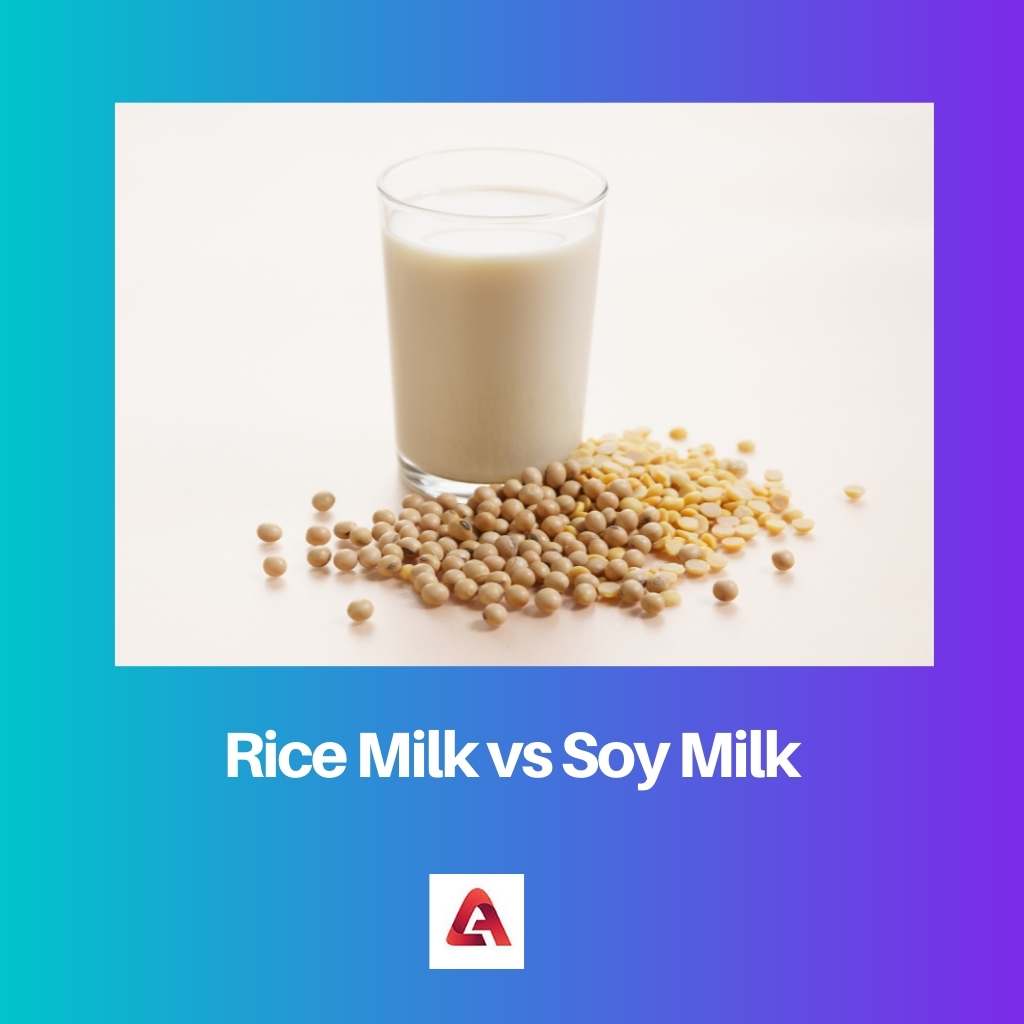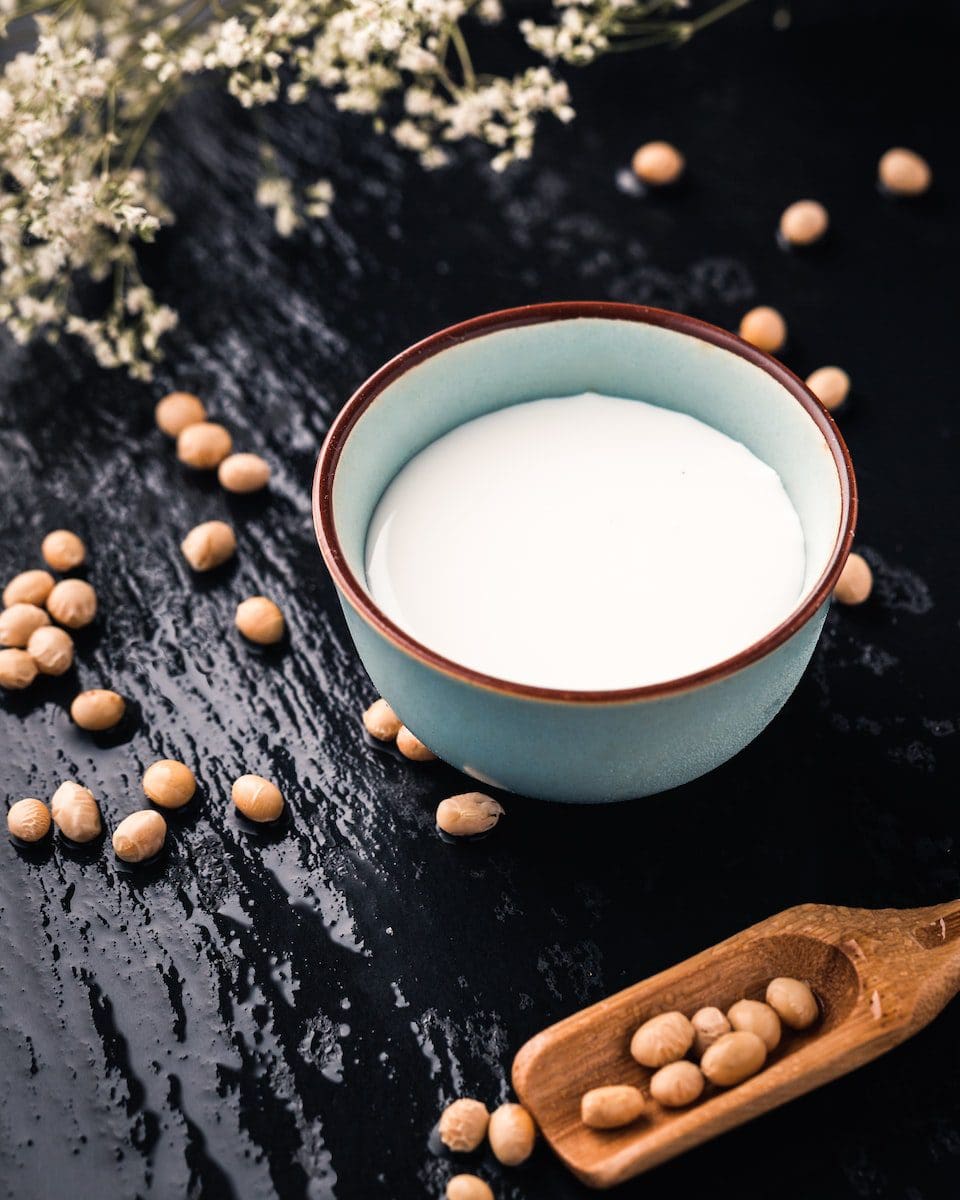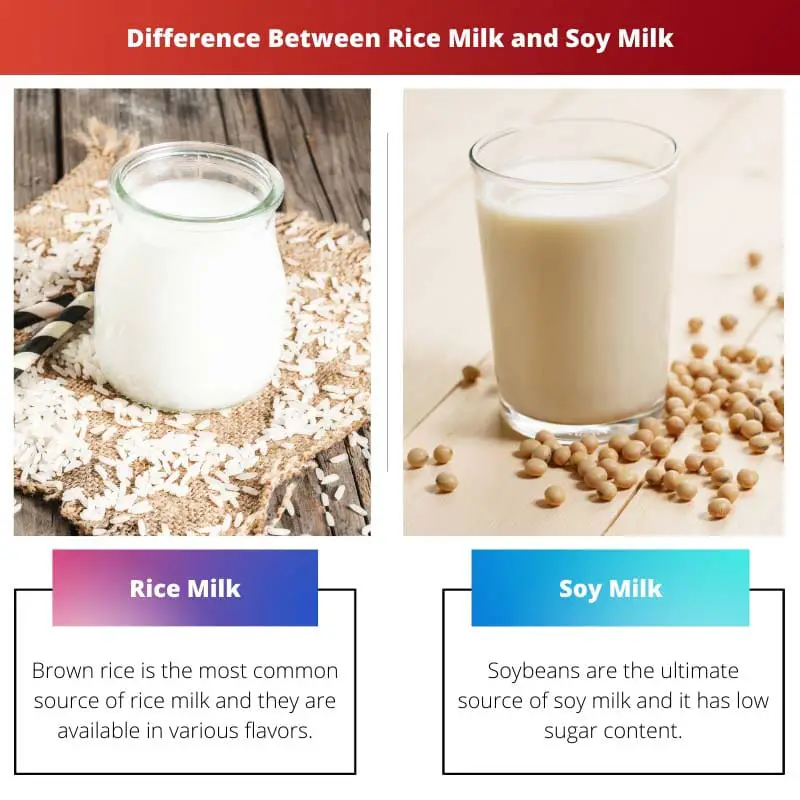With veganism gaining more popularity, replacements for animal-based products are a big catch in today’s market. Milk is one of the most common dairy products that act as a good source of high-quality protein and fat.
Plant-based milk like rice and soy milk are on every vegan and health-conscious person’s grocery list. Different plant-based milk provides different nutritional values that increase the number of choices for us.
Key Takeaways
- Rice milk is a dairy-free milk alternative made from rice, while soy milk is a dairy-free milk alternative made from soybeans.
- Rice milk is thinner and sweeter than soy milk, while soy milk has a thicker consistency and a nuttier flavor.
- Rice milk is hypoallergenic and suitable for people with lactose intolerance, while soy milk is a good source of protein and suitable for vegan people.
Rice Milk vs Soy Milk
Rice milk is made by blending rice grains with water and then straining out the solids, resulting in a smooth, creamy liquid that is slightly sweet in flavour. Soy milk is higher in protein, made by soaking and grinding soybeans and then boiling the mixture to extract the milk-like liquid.

Rice milk is a popular alternative to any animal milk, and it is one most hypoallergenic milk products. It has the least amount of fat compared to other plant-based milk and is cholesterol-free.
Though rice milk is a good substitute for people who are lactose intolerant or have nut allergies, it is not a good choice for diabetic patients because of its high carbohydrate.
Soy milk is more popular than rice milk as it contains high-quality proteins, essential omega-3 fatty acids, and very sugar content. One cup of soy milk contains 80 calories which is more than the calorie content of almond milk.
Some studies show that the consumption of soy milk reduces the risk of osteoporosis and heart disease.
Comparison Table
| Parameters of Comparison | Rice Milk | Soy Milk |
|---|---|---|
| Source | Brown rice is the most common source of rice milk and they are available in various flavors. | Soybeans are the ultimate source of soy milk and it has low sugar content. |
| Processing | Rice goes through a milk stream which is converted into a paste. The liquid obtained from it is rice milk. | The soybeans are soaked in water and grounded to make a fine paste. The paste is strained to obtain soy milk. |
| Nutritional value | Rice milk contains 22 grams of carbohydrate and 2 grams of fat per cup. It is a good source of vitamin B and antioxidants. | Soy milk contains 4 grams of carbohydrate and fat each per serving. It is also a good source of high-quality protein. |
| Consistency | Rice milk doesn’t have a very thick consistency as it contains very little natural fat. Many brands use tapioca to thicken it. | Soy milk has comparatively a thicker consistency as compared to rice milk and almond milk. |
| Calorie Content | Standard flavorless rice milk contains 120 calories per cup of serving. | Standard flavorless soy milk contains 80-100 calories per cup of serving whereas light soy milk contains 50 calories for the same quantity. |
| Origin | In the early 21st century, rice milk became popular as Vita Rice Products Co started selling it in California. | Soy milk is originally from China but in the second half of the 20th century, it became a common drink in North America and Europe. |
| Diabetic Patient | Rice Milk is not appropriate for diabetic patients as it contains 3-4 times more carbohydrates than soy milk. | Soy milk is a better choice for diabetic patients because of its low sugar content and ability to decrease blood glucose levels. |
What is Rice Milk?
Rice milk is a plant-based beverage that is available commercially in many flavours. Apart from using brown rice and water, the main ingredients for manufacturing rice milk, the commercial products also contain many plant-based oils, sweeteners, and flavourings.
One cup of rice milk contains 120 calories. They have high carbohydrate and calcium content. It is also rich in vitamins A, B12, and D.
To meet the nutritional need, rice milk is sometimes fortified with micronutrients, and to make it taste, various good flavours like chocolate, vanilla, etc. are added.
Rice milk has various health benefits, including improving bone density (presence of Vitamin D and calcium), preventing Vitam B12 deficiency (a deficiency that causes fatigue, weakness, megaloblastic anaemia), etc.
It is not appropriate for diabetic patients because it contains high carbohydrates.
No products found.
What is Soy Milk?
Soy milk is a better plant-based milk option than rice milk because of its high protein and essential fatty acid content. If one doesn’t have alternate allergy directions from soybean, then he/she can replace animal milk with soy milk.
But, they are a bit expensive as compared to other kinds of milk.
Soy milk can reduce obesity and high blood pressure and maintain a healthy body weight. It is also rich in vitamins and minerals and improves the health of the heart, combined with a low cholesterol level.
Soy milk is also known for curing hyperpigmentation and has anti-ageing properties. Some of the other health benefits are increasing bone density, better hair growth, antidepressant, etc.
No products found.

Main Differences Between Rice Milk and Soy Milk
- Brown rice is the most common source of rice milk, whereas soybeans are the ultimate source of soy milk.
- Rice goes through a milk stream which is converted into a paste, whereas the soybeans are soaked in water and grounded to make a fine paste,
- Rice milk contains 22 grams of carbohydrates and 2 grams of fat per cup, whereas soy milk contains 4 grams of carbohydrates and fat each per serving.
- Rice milk doesn’t have a very thick consistency as it contains very little natural fat, whereas soy milk has a comparatively thicker consistency.
- Standard flavourless rice milk contains 120 calories per serving, whereas standard flavourless soy milk contains 80-100 calories per serving.
- Rice Milk is not appropriate for diabetic patients as it contains 3-4 times more carbohydrates than soy milk. On the other hand, soy milk is a better choice for diabetic patients because of its low sugar content and ability to decrease blood glucose levels.




